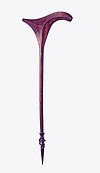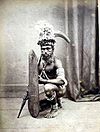Roromaraugi
A roromaraugi is a parrying shield from San Cristobal Island in the Solomon Islands.

Roromaraugi

Makira warrior handling a roromaraugi in his right hand
Uses
It was used to deflect the enemy’s arrows and spears. It has a broad sickle shaped head[1] that is separated by a well-marked central ridge with an ergot at his back. The handle is often finished by an anthropomorphic sculpture and the whole is done in very hard wood.[2] It was also used in war dances and measures more or less 150 cm.[3] It should not be confused with the qauata which does not have an ergot and looks more like a leaf.[4]
gollark: There's no way Google has useful information.
gollark: Unlikely, this is *such* a niche topic.
gollark: Not actually how it works or any details other than that it's hard to exploit.
gollark: I vaguely mentioned its existence to them.
gollark: The Nether might not even *have* GPS, but nobody cares.
References
- The British Museum Yearbook, British Museum, 1979, p.218
- Deborah Waite, Art of the Solomon Islands, 1983, p.135
- Douglas Newton, Arts des mers du sud: Insulinde, Mélanésie, Polynésie, Musée Barbier-Mueller, 1998, p.270
- Deborah Waite, Art of the Solomon Islands : The Conru Collection, 2008, p.113
Bibliography
- Purissima Benitez, Jean-Paul Barbier, Alain-Michel Boyer, Boucliers d’Afrique, d’Asie du Sud-Est et d’Océanie, Paris, Éditions Adam Biro, 1998.
This article is issued from Wikipedia. The text is licensed under Creative Commons - Attribution - Sharealike. Additional terms may apply for the media files.
